
"They're Cutting Corners in 2003"
~ or ~
A Long, Hard Look At
the Future of the SIGGRAPH Conference
by Alan B. Scrivener, Chair
San Diego Professional Chapter ACM SIGGRAPH
|
"They're Cutting Corners in 2003"~ or ~
A Long, Hard Look At
|
Greetings, fellow SIGGRAPHers. This year marked my 14th SIGGRAPH conference, over a period of 20 years. To earn the Media Pass which was bestowed upon me I am writing this article. But there are already numerous articles out there offering detailed looks at this years's conference from a number of perspectives. Here is a random sample:
So I thought I would focus instead on a long-range view of the conference and its place in the tech world. As a chapter leader I was an invited attendee at the Chapters Leadership Workshop on the Saturday before SIGGRAPH, 25 July 2003. The one question we were asked repeatedly to ponder and discuss was "What is the future of SIGGRAPH?" Clearly this question has been on a lot of people's minds.
This year was the first time the SIGGRAPH conference has been held in San Diego, and early in the planning -- back in late 2001 -- the San Diego chapter was invited to participate in the process. We kicked around a number of ideas with Alyn Rockwood and his staff, and ended up with the San Diego Professional Chapter producing the 2003 SIGKIDS event (more on that later).
One of the ideas that didn't make the cut was a video production based on a retelling of Dickens' A Christmas Carol, called A SIGGRAPH Carol, hoping to educate and inspire all the Scrooges out there into adopting the "Spirit of SIGGRAPH," in a search for beauty and truth combined with boosterism, volunteerism and community outreach.
I'm borrowing that pretext now for this article. Come with me, Ebineezer, this is your old partner Marley, the three spirits will be taking you to see SIGGRAPHs present, past and future.
It's hard to say when a SIGGRAPH conference begins. SIGGRAPH 2003 began for me when I found out -- when? 2000? -- that San Diego would host it. Our chapter started our own planning and brainstorming then.

In winter of 2002 I was "drafted" into producing SIGKIDS. A lot started happening after that: we started having monthly SIGKIDS meetings with on-site child care to be family-friendly. Many of them were held at the new Immersive Visualization Lab. at San Diego State University (CSL-120, www.edcenter.sdsu.edu/news/news_2002.html), which helped our campus and community outreach.
Often it seems like a SIGGRAPH begins the previous your with the "next year's" booth giving away posters and pins. At San Antonio 2002 I ran into Mike from Scripps amid rumors of that years's conference losing money due to low attendance, and the 2004 conference moving from ATlanta to Los Angeles to be closer to show-biz customers. He pointed to his 2003 pin (see title above) with its classic punch card design, and said "They're Cutting Corners in 2003."
SIGKIDS work the increasingly intense through 2003, until by the 4th of July I decided to take a month off (from my projects that actually make me money) to spend full-time on it until the conference.
In June of 2003 I did some volunteer work for the Air & Waste Management Association Conference (http://www.awma.org/) held at the San Diego Convention Center, the same venue where SIGGRAPH would be. I got to experience the parking, meal and transportation problems ahead of time.
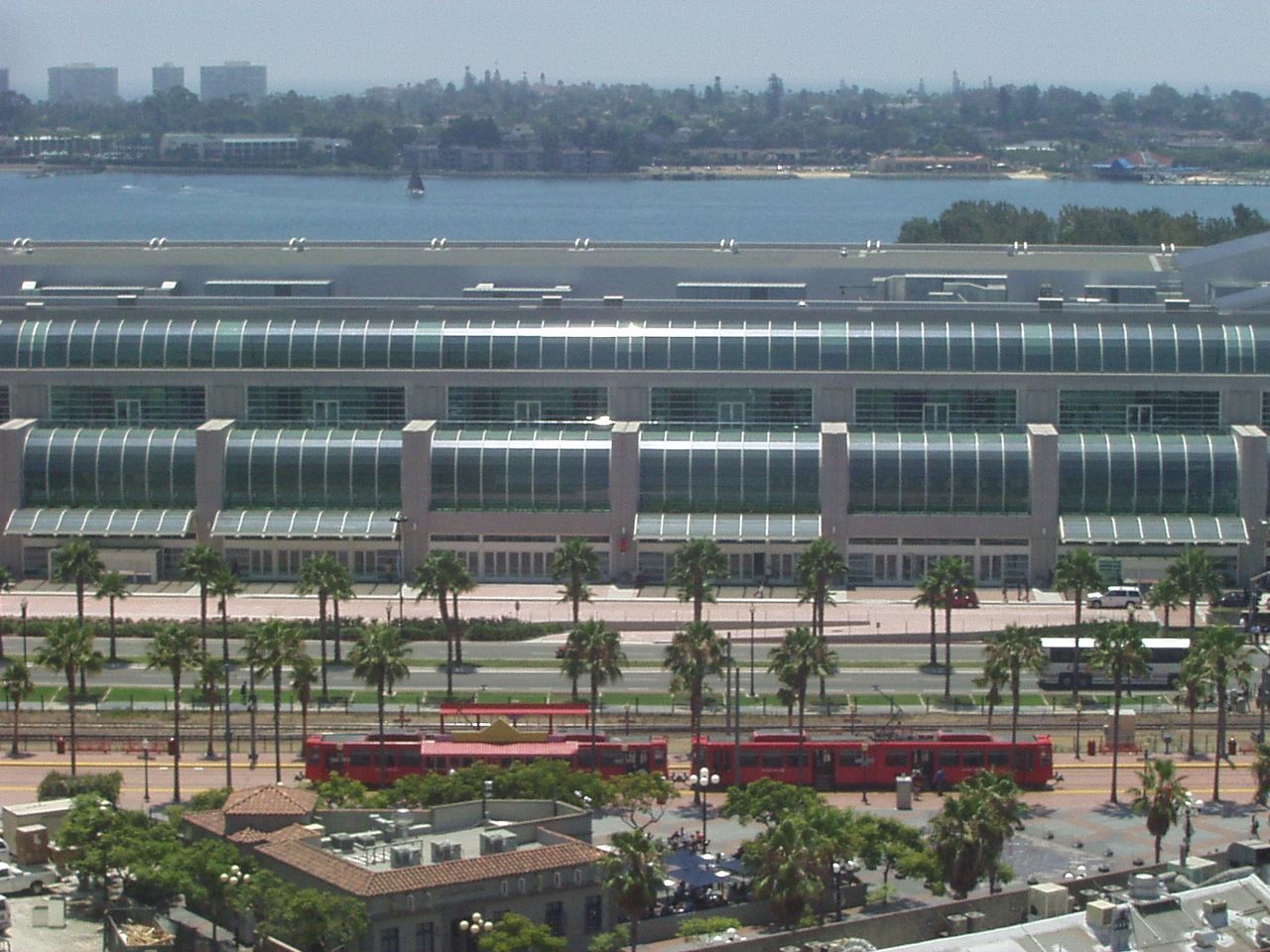
I got to experience it on a much larger scale a few weeks later when I and my chapter plus some other kind volunteers staffed a table for four days at ComicCon, the huge comic book convention (http://www.comic-con.org/). We used a screen and projector to show some 2003 animations off DVD, and handed out literature for the San Diego chapter, SIGRAPH 2003, and SIGKIDS 2003. It was fun but exhausting. Afterwards I saw two teenagers at the trolley stop; one was holding a cigarette. The other asked, "You need a light?" His friend answered, "No, I've got a lighter. I'm just too tired to smoke." Even though I don't smoke myself, I knew what he meant.
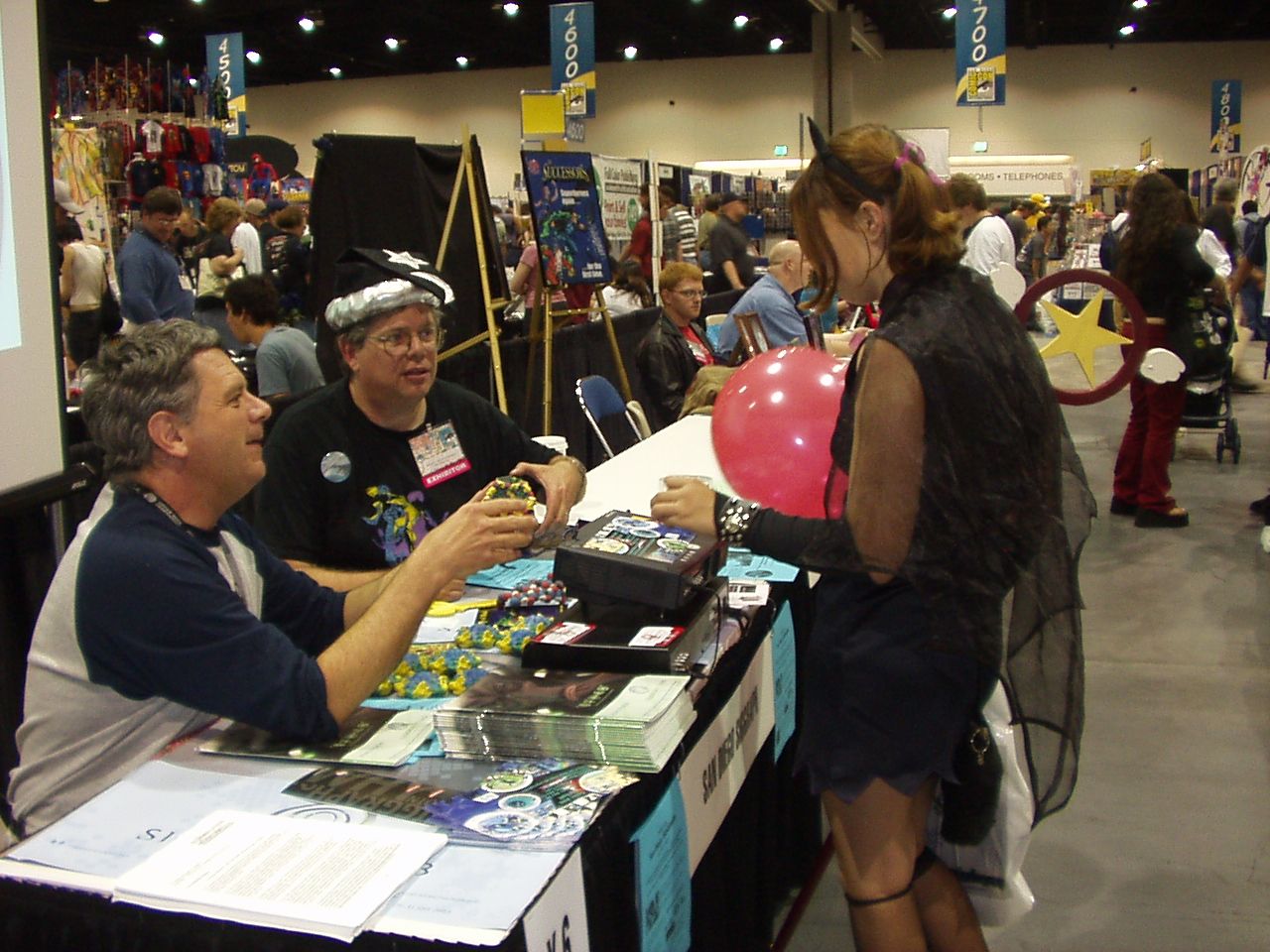
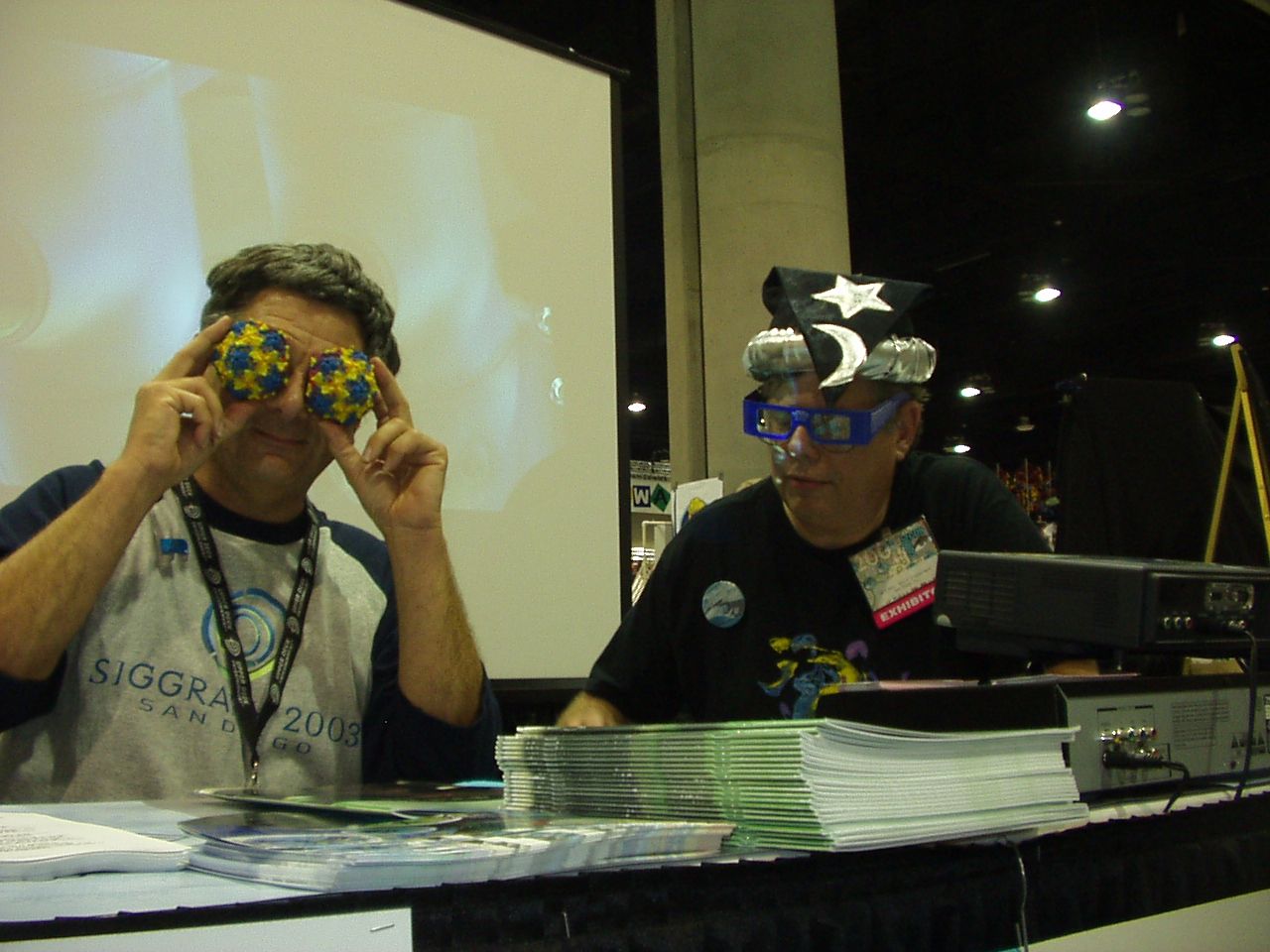
Soon afterwards I sent out the following email to my fellow chapter leaders coming to the workshop:
Greetings fellow SIGGRAPHers. Here are my last-minute survival
tips for San Diego. Feel free to share this with your members
who are attending.
If you have visited the SD Conv. Cent. before its expansion,
you will need to readjust. It is twice as big now. If you were
to walk West to East along the front of the center, with the
trolley tracks to your left and the building -- and the bay beyond
-- on your right, there are big round, red labels on the outside
of the building with the letters beginning with A. In the old
days the letters went from A to D, with A near 1st Street and the
"Convention Center" trolley stop, and D near 5th St. and the
"Gaslamp Quarter" trolley stop. Inside the center, at about
C, were 2 sets of escalators, one going West to East as it went
up, and the other a mirror image. Near the bottom of the escalators
is an ATM machine inside the building, and 2 elevators to parking
outside the building.
All of that is still there, but the building stretches to H now,
and has another set of escalators in the new wing without a mirror
twin and without ATM or elevators at the bottom.
Also be aware that all the underground parking is under the old
A-D wing, and if you park in section G15 (for example) it has nothing
to do with section G in the Conv. Cent. itself. Oh, and there are
2 G15s, on levels P1 and P2. Note your level. Near the parking
elevators are 2 sets of stairs: the West one goes all the way down to P2,
and the East one goes only to P1.
If you are driving and need Conv. Center parking, you may need to
arrive early. Comic-Con had 50,000 people on the busiest day, and all
4 days there was no parking ANYWHERE downtown south of C street and
west of 7th after 10 AM. SIGGRAPH will be a smaller show but will
also probably max out parking. The preferred parking choices are:
1) under the Conv. Cent. ($8), 2) under the Mariott next door to the
west ($8), 3) behind the Conv. Center to the south (bay side),
4) Seaport Village to the west (upwards of $50/day), 5) Community
Concourse building at 1st and B ($18/day). If you use the last two
you may want to take a trolley or pedi-cab to the center.
Speaking of transportation, bring lots of cash for the pedicabs
and change for the trolley. Buy a $2.50 zone A round trip trolley
ticket 1st thing in the morning, perhaps when you pass a station.
I think it's good all day. Later when you are running for a trolley
it may make the difference catching it and having to wait 30 more
minutes.
Check the routes and schedule at:
www.sdcommute.com/RiderInfo/trolley/trolleymap.asp
and memorize the schedule for a station you expect to use a lot.
You can derive the others by adding or subtracting a few minutes.
My recommended eateries are:
* LC's in the Marriott
$15 breakfast buffet
worth it for the time it saves,
especially if someone else's money
(
www.marriott.com/epp/factsheet.asp?marshacode=SANDT&EPCEC=InProcess&E
NAVCEC=InProcess )
* Buster's Beach House
at Seaport Village
open for breakfast
casual, bay view
( www.bustersbeachhouse.com/html/bbhsdframeset.html )
* Joe's Crab Shack at the Rowing Club
50 yards south of the Conv. Center
casual fun dining, dancing waiters
( www.joescrabshack.com )
* Rockin' Baja Lobster
2 blocks north of Gaslamp trolley stop
310 Fifth Ave, 619 234-6333
casual, close, lots of food
* Greek Islands Cafe
in food park of Seaport Village
( www.greekislandscafe.com/ )
casual, usually uncrowded, great bay view
* California Cafe at Nordstroms
Horton Plaza
(619) 239-1700
take elevator at 1st and G to top floor,
walk through store to cafe on right
upscale casual food, great view of Conv. Cent.
* Pat and Oscar's
1st & Island
next to Starbucks
across the street from Ralph's supermarket
casual, nice street scene
( www.breadstick.com/FindNearestOscars.tpl#loc3 )
* Top of the Hyatt
take elevator to top of Hyatt Hotel east bldg.
drinks and sandwiches at absurd prices, best view in town
( www.hotels-rates.com/hotels_reservations/property/20074/ )
My secret shortcut from the Conv. Center to Seaport Village:
Walk west along the city side of the center, and follow the
building as it bends into the Mariott. Take the little
Mariott guest entrance (not the employee entrance next to it)
and go up the escalators, turn right and walk so the bay
and pool view windows are on your left, through the lobby
until you can veer left into the entrance to a little
bar with a sign saying it's the way to Molly's and LC's.
Go down the stairs, pass LC's (see above), go outside, pass
the pool with the waterfall, go out the iron gates past the
Yacht Club, and turn right onto the sea wall path. Keep heading
west to Seaport Village.
Upstart Crow is a great bookstore/cappuccino bar there.
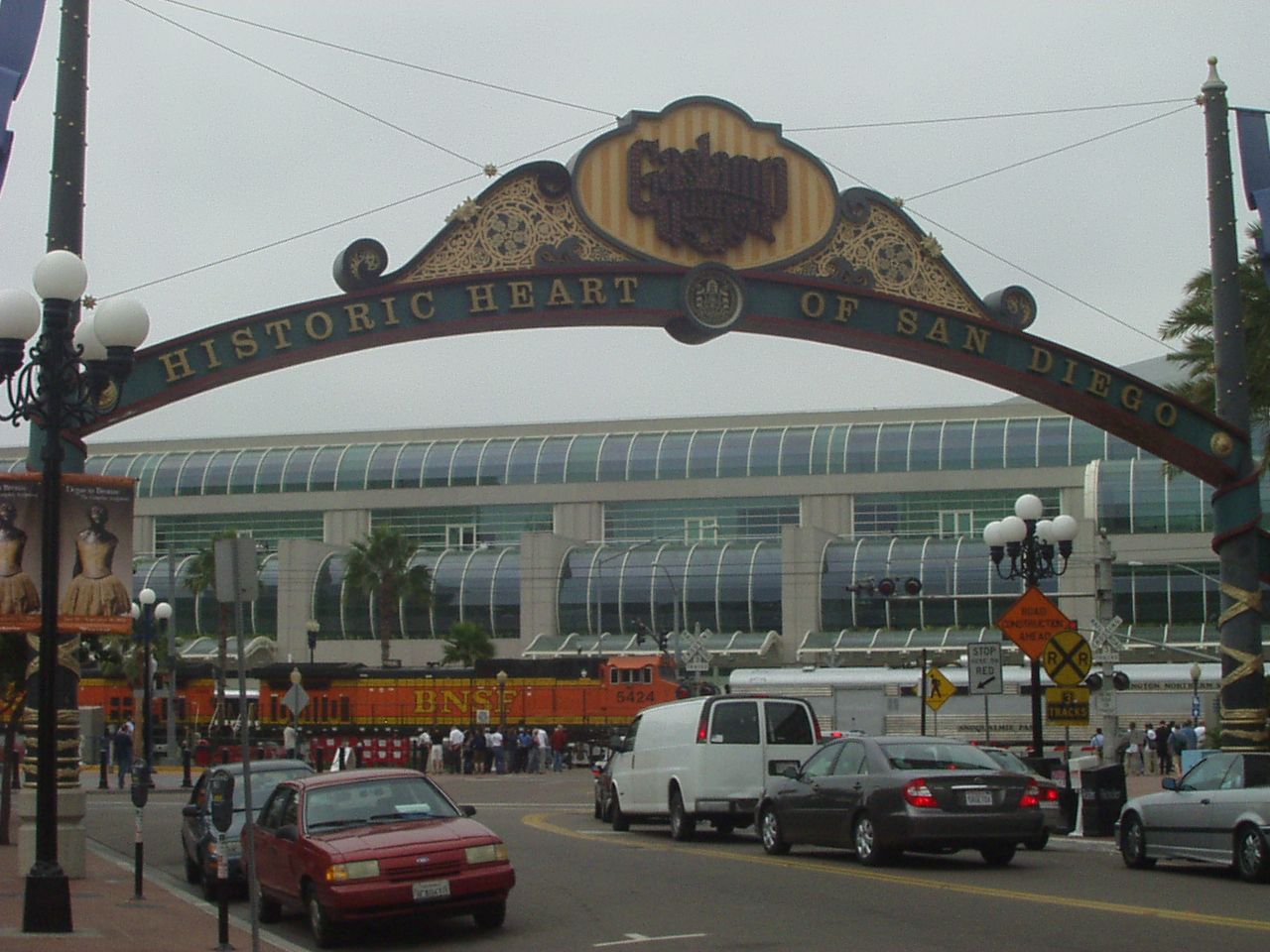
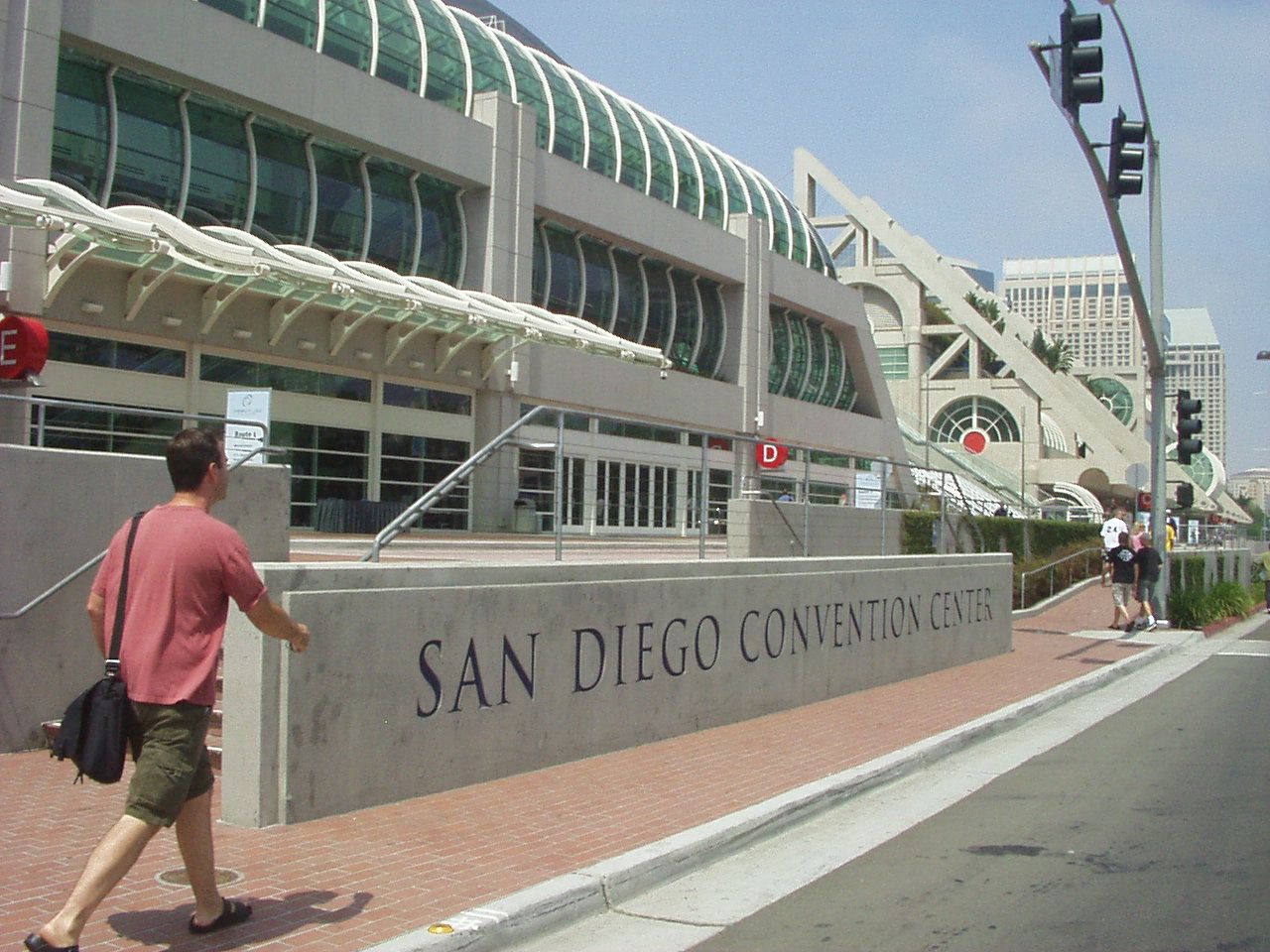
Finally, SIGGRAPH "began" on Sunday 26 July 2003. I spent a good part of the day moving tables, cables, and a large art installation made of 16 DOS systems and plywood, into the SIGKIDS venue, the Computer Museum of America in downtown San Diego (www.computer-museum.org). I also attended a meeting, picked up badges for my volunteers and distributed some of them, and solved last-minute problems. I didn't make it to the Art Party in Balboa Park or sake barrel ceremony.
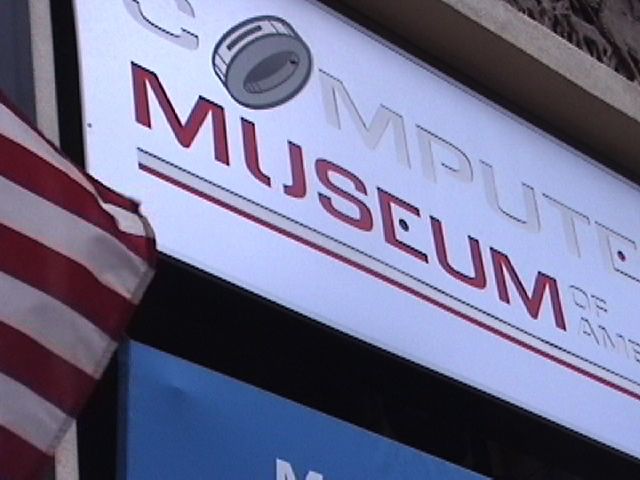
Monday was SIGKIDS set-up, so I didn't make it to the class on programming graphics for dome displays. But watching this magic space being created in the basement of the museum was mind-blowing.
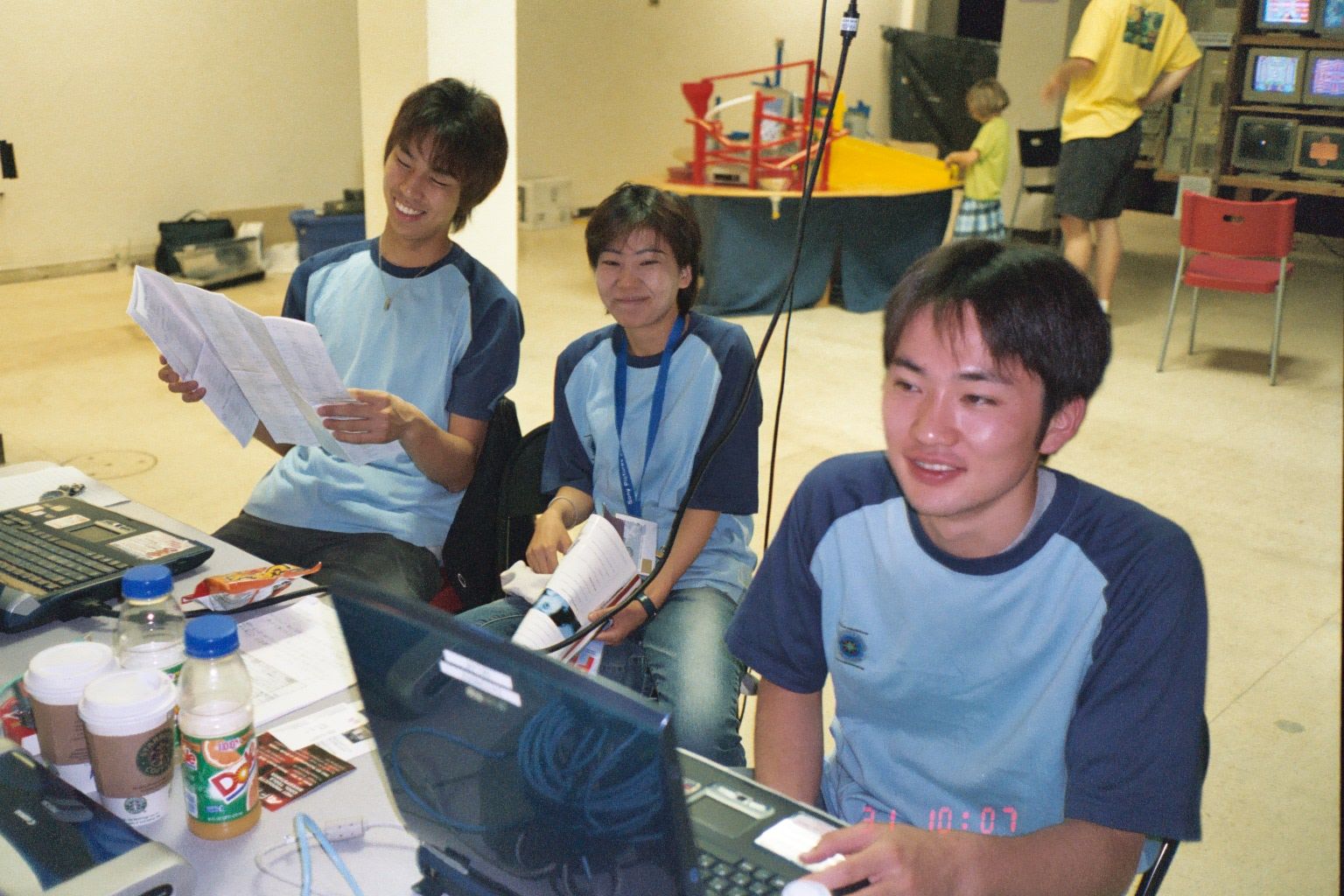
That night we had our SIGKIDS 2003 awards banquet, and afterwards I was planning on going to the Professional Chapters Party which sounded like a blast, but I was too wiped out.

Tuesday morning SIGKIDS opened for its 3-day run. Each day I left for two to four hours to check out the rest of SIGGRAPH, but mostly stayed at SIGKIDS to make sure things went well.
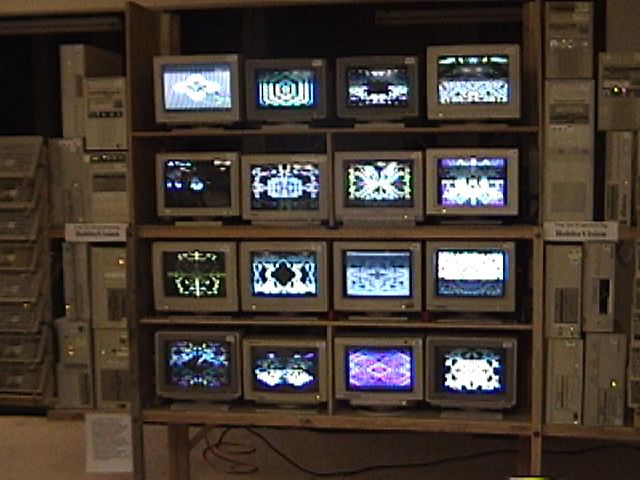
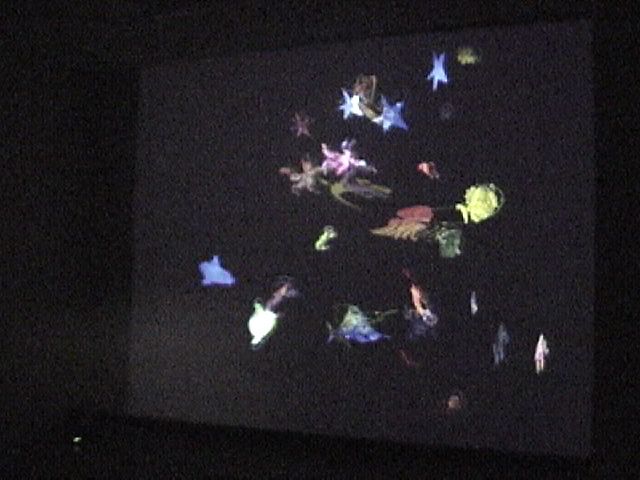
Floated Through My Mind installation, SIGKIDS 2003
Rakugaki installation, SIGKIDS 2003
when I did foray over to the Convention Center from the Computer Museum, I saw the standard stuff. I spent a good teal of time in Emerging Technologies, making sure I understood each display before going on to the next.
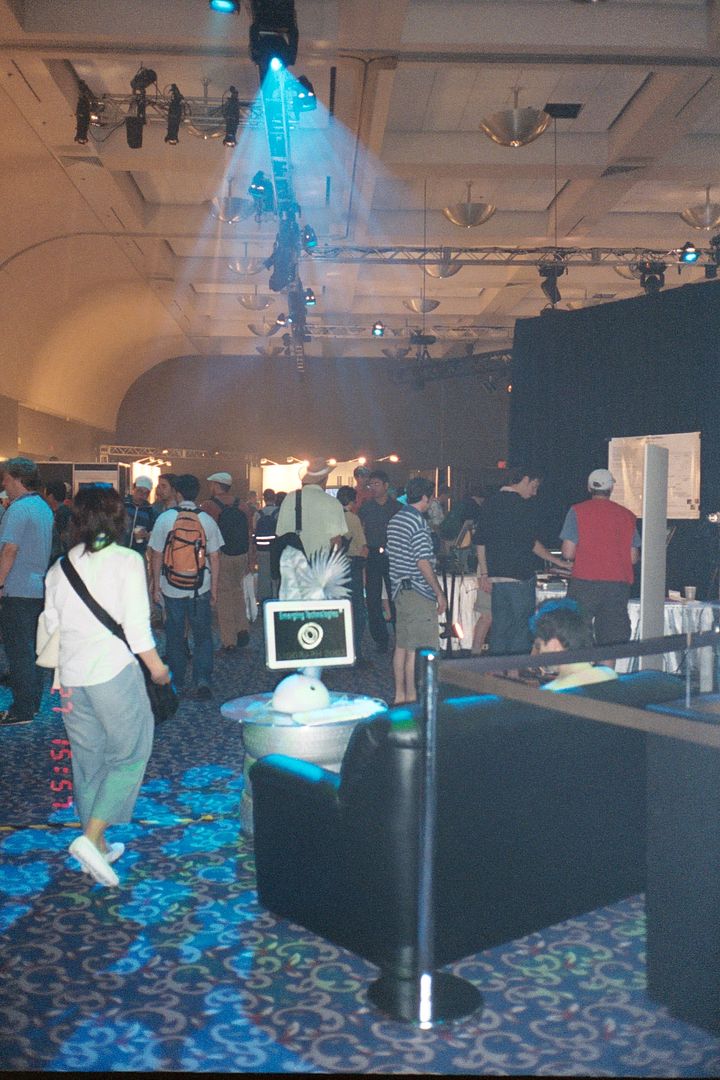
Later, talking to my friend Bob, he told me about an exhibit in Emerging Technologies that I'd completely missed. It was "The Augmented Composer Project: The Music Table" (www.siggraph.org/s2003/conference/etech/augmented.html). So much for seeing and understanding everything! I just walked right by this one unknowingly. Sensory overload is difficult to manage sometimes.
I also really enjoyed all the whimsical stuff under the sail.
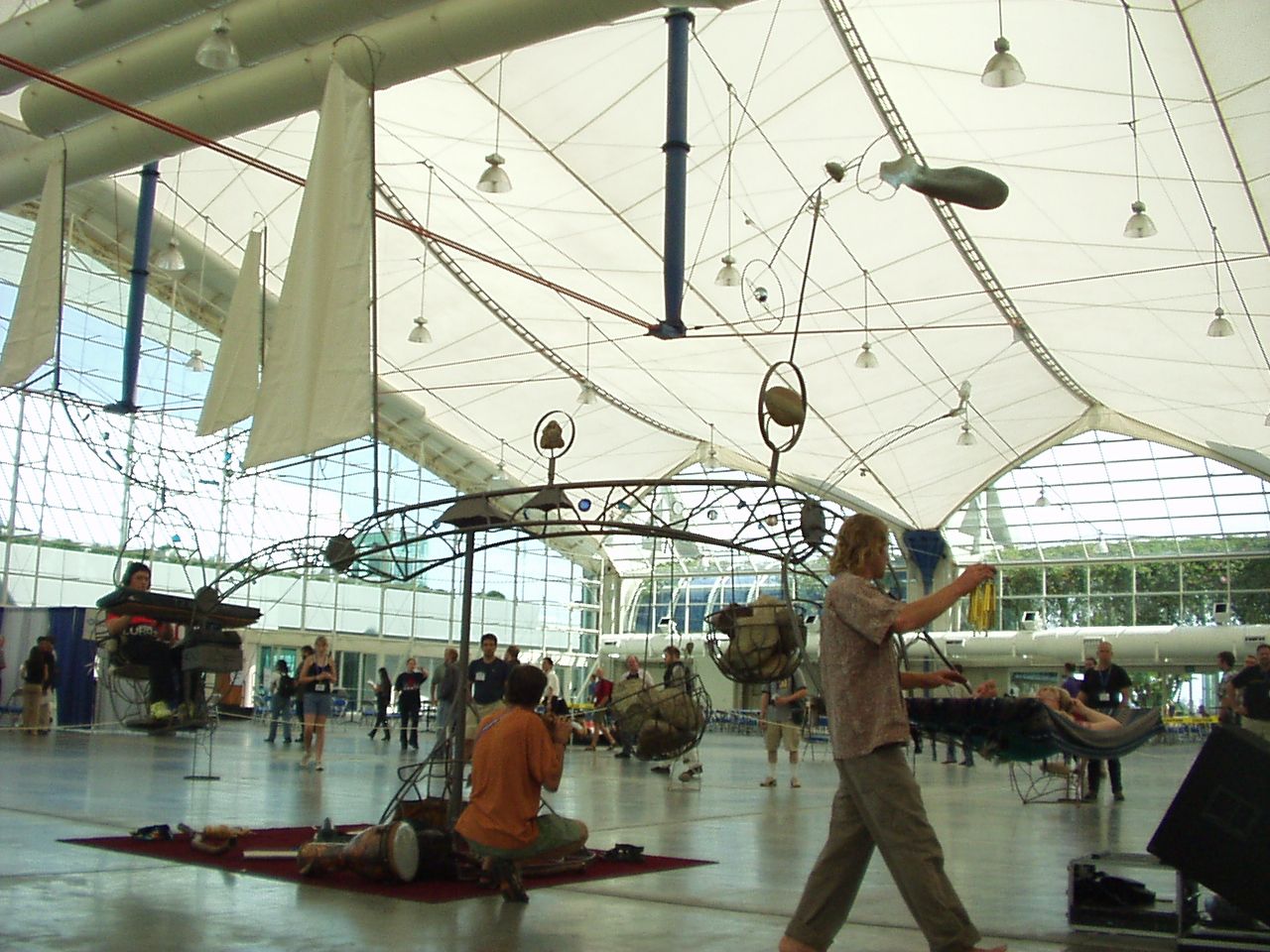
And of course I spent some time on the exhibits floor. If I hadn't been at ComicCon in the same facility a week earlier, I might not have noticed that SIGGRAPH used less than half the newly-elongated (mile long) exhibit hall, while ComicCon filled it.
There was certainly a list of things I'd wished I been able to make to this year (like every year). Some of the things I was sorry I couldn't squeeze in were the excellent-sounding short presentations in the Educator's Program, the Graphics Pioneers dinner, and the Wearable Computers Fashion Show, as well as a a number of technical sessions. I realized that the people who put on the conference are not the people who attend the conference. The volunteers who make SIGGRAPH happen seldom get to enjoy its riches much, and go home exhausted. Michael Wright the Art Show Chair, told me he slept for a week afterwards.
But I did get to talk to a lot of people who came through SIGKIDS, and I asked many of them what they'd seen at the show that was new and/or exciting. People kept telling me that it was more of the same from previous years. "Stuff is cheaper," I heard more than once, "but nothing's new."
Yet a few things were new. I saw a system for using the human body's own electric fields for a local area network in Emerging Technologies. It was called ElectAura-Net (www.siggraph.org/s2003/conference/etech/electaura.html). I also saw a "free ice cream" truck on 5th Ave. leading to the convention with young women handing out demo CDs of a new program with each ice cream bar. That was a new one.

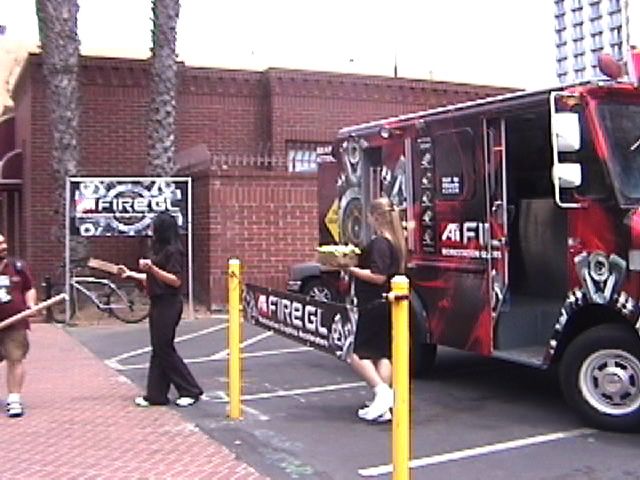
But it got me wondering: if the big studios are laying off animators, and Disney dropped most animator salaries by one third last year, are we really doing a good thing by encouraging more and more people to learn these skills and enter this field?
So, after my week of sleep, I began to think some more about the future of SIGGRAPH.
One of my all time favorite SIGGRAPH conferences was in Anaheim, CA in 1993. It was the year SGI had a giant Jurassic Park theme park ride in their 4-times-the-biggest-size booth. But only a tiny fraction of the vendors dealt with F/X. In many ways it was the last of the "old style" SIGGRAPHs, dominated by scientific visualization and graphics researchers. The funny thing is that lately it seems like every time I see somebody doing something praised as "innovative" in graphics, it's based on a paper given at SIGGRAPH 1993. For example, when I attended the course at SIGGRAPH 2001 on "Shrek": The Story Behind the Screen (http://www.siggraph.org/s2001/conference/courses/crs19.html), they said the skin rendering used algorithms from a 1993 SIGGRAPH paper. Fractal data compression, Artificial Life (AL), Virtual Worlds -- all were fresh, new ideas in 1993. I thought about this when the 2003 Electronic Theater began with a retrospective of the 1993 Electronic Theater.
Most years have an experience, demo, prototype or artwork that blows my mind. For example, here is a description I've lifted from the 2003 SIGKIDS proposal:
|
[In trying to find enriching interactive computer graphics experiences for my
6 year old daughter,] ...one very successful encounter occurred at
SIGGRAPH 1999 Los Angeles,
in the art show, with an installation called Composition on the
Table, No.1 [PUSH], No.2 [TWIST], No.3 [TURN], No.4 [SLIDE]
by Toshio Iwai, Mixed Reality Systems Laboratory Inc., Yokohama, Japan.
The whole experience is hard to describe because it was totally devoid of language. One entered a large room of scrim material, with blue lights projected from the outside, creating a bright, deep blue cube which in itself induced a feeling of calm and beauty. Inside were four white tables. Each had a unique set of user interface devices, and some computer graphics projected from above. For example, one table had buttons. The buttons affected the graphics on the table. Nothing was explained. Every few minutes, there was a strange sound and the graphics seemed to swirl "down the drain." After that, new graphics appeared, and the way the buttons affected the graphics had changed. Another table had wheels one could spin, which affected the graphics on that table. Again, every few minutes, there was the same strange sound and the graphics also seemed to swirl "down the drain." And of course, after that, new graphics appeared, and the way the wheels affected the graphics had changed. It was the same at the other two tables, just different devices. Kids loved this. My daughter loved this. I loved this. I just knew it was en enriching experience for her; I could almost feel her IQ being boosted. |
I worked very hard on SIGKIDS and appreciate the work of the conference committee and their staff, and I don't mean this as a criticism of them; I know they are dependent on what is submitted to the conference, and that in turn depends on the research and economic climates, and what innovation there is to be found, but I have to say that the conference is losing its edge. I have one friend who says he's found some of the same old excitement -- and even some of the same people from "old SIGGRAPH" -- at the Burning Man Festival (www.burningman.com/). Others have said the Electronic Entertainment Expo (E3) Show (www.e3expo.com/) is where all the newest 3D stuff is. These trends all worry me, as do the tales I'd heard of large losses (in some years) and declining attendance and exhibitors. 2003 was the first year SGI didn't even have a booth.
So I decided to at least get my facts straight. Alyn Rockwood and Jen Anderson were kind enough to provide me with some preliminary figures for 2003 and archival data for other years, which I combined with data from previous ACM SIGGRAPH reports and press releases to create the following table:
| Year | Place | Attendees | Sq. ft. exhibs. | Profit/loss (US dollars) | Industry (milllions of US dollars) |
|---|---|---|---|---|---|
| 1974 | Boulder, CO | 600 | 0 | 540 | |
| 1975 | Bowling Green, Ohio | 300 | 0 | 830 | |
| 1976 | Philadelphia, PA | 300 | 1,000 | 1,100 | |
| 1977 | San Jose, CA | 750 | 10,000 | 1,500 | |
| 1978 | Atlanta, GA | 1,500 | 12,000 | 2,000 | |
| 1979 | Chicago, IL | 3,000 | 25,000 | 2,300 | |
| 1980 | Seattle, WA | 7,500 | 26,300 | 2,800 | |
| 1981 | Dallas, TX | 14,000 | 40,560 | 4,000 | |
| 1982 | Boston, MA | 17,000 | 53,795 | 5,000 | |
| 1983 | Detroit, MI | 14,000 | 68,575 | 6,700 | |
| 1984 | Minneapolis, MN | 20,390 | 72,990 | 9,000 | |
| 1985 | San Francisco, CA | 27,000 | 79,200 | 12,200 | |
| 1986 | Dallas, TX | 22,000 | 97,000 | 13,100 | |
| 1987 | Anaheim, CA | 30,541 | 109,200 | 14,000 | |
| 1988 | Atlanta, GA | 19,000 | 103,050 | 17,100 | |
| 1989 | Boston, MA | 27,000 | 96,170 | 20,400 | |
| 1990 | Dallas, TX | 24,684 | 104,850 | $334,100.00 | 23,400 |
| 1991 | Las Vegas, NV | 23,100 | 106,800 | -$298,383.00 | 27,000 |
| 1992 | Chicago, IL | 34,148 | 96,900 | $210,313.00 | 31,500 |
| 1993 | Anaheim, CA | 27,000 | 103,250 | $611,056.00 | 36,000 |
| 1994 | Orlando, FL | 25,000 | 107,600 | $612,855.00 | 39,600 |
| 1995 | Los Angeles, CA | 40,100 | 126,000 | $1,631,768.00 | 43,300 |
| 1996 | New Orleans, LA | 28,800 | 157,800 | $2,763,229.00 | 50,000 |
| 1997 | Los Angeles, CA | 48,700 | 182,600 | $684,526.00 | 56,100 |
| 1998 | Orlando, FL | 32,210 | 171,975 | $176,680.00 | 50,000 (wild guess by author) |
| 1999 | Los Angeles, CA | 42,690 | 154,000 | $316,613.00 | 45,000 (wild guess by author) |
| 2000 | New Orleans, LA | 25,986 | 143,000 | $897,806.00 | 40,000 (wild guess by author) |
| 2001 | Los Angeles, CA | 34,024 | 126,000 | -$561,535.00 | 35,000 (wild guess by author) |
| 2002 | San Antonio, TX | 17,000 | 82,000 | -$2,060,688.00 | 30,000 (wild guess by author) |
| 2003 | San Diego, CA | 24,332 | 68,000 | -$5,616.00 | 25,000 (wild guess by author) |
I wanted to graph this data in a meaningful way, and so after some "visual experiments" I came up with plotting each number "normalized" (abbreviated N in the key) as a per centage of its 1995 value (a very good year for SIGGRAPH). The red bars are attendance, the blue bars are square footage of exhibits, the yellow line is profit or loss (where information was available), and the gold line is estimates of the size of the "graphics industry." Where the gold and yellow lines cross, and the red and blue bars are the same height, is the year 1995. (Beware; as the table above shows, these industry numbers after 1997 are my own wild guesses. SGI usually knows why its customers buy servers; Dell seldom does.) Here are those plots:
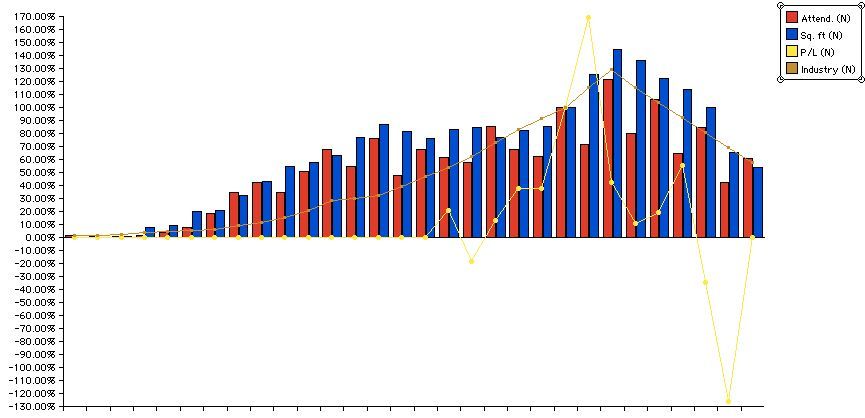
While this graph makes it clear that this year's conference committee has "pulled the airplane out of the nose-dive," but our base of attendees and exhibitors is still faltering. I get the impression that the current strategy is to "batten down the hatches" and wait out the slump, until the "cheese" moves back. (To understand this metaphor, see Who Who Moved My Cheese? An Amazing Way to Deal with Change in Your Work and in Your Life (1998) by Spencer Johnson [ISBN#0399144463]). But what if the cheese isn't going to move back?
It is a distinct possibility that SIGGRAPH will never be as big again. One other thing that happened in 1993 -- in the heyday of 3D -- was that I realized that one day SIGGRAPH would be gone. I explained it this way to friends: "Do you use pencils? Me too. When was the last time you went to a pencil conference?" I saw that the more mainstream 3D graphics became, the less it would need a conference.
I thought the day would come, but I didn't think it could be so soon. The crash of the "dot cons" has humbled us all. But, as it was said in The Tea House of the August Moon, pain makes one think, thought makes one wise, and wisdom makes life more endurable. One of the great thoughts to come out of recent high-tech misfortunes is presented in The Innovator's Dilemma (1997) by Clayton M. Christensen [ISBN#0060521996]. (All Amazon links in this article will pay into my Associates account if you order throught them. I will donate all proceeds to the SIGKIDS San Diego 2007 fund.) Christensen, at Harvard Business School, has made a study of how high-tech markets implode. He debunks the myth that it's because "big companies just can't innovate." Big companies innovate just fine when dealing with what he calls "sustaining technologies," which can be incrementally improved to match customer demands. But it is "disruptive technologies" which kill companies, because customers say they don't want them, and a month later they all buy them. This is what minicomputers did to mainframes, and what Walmart did to Sears, and what (hydraulic) ditch witches did to (cable-driven) steam shovels, and what 5 1/2 inch disks did to 8 inch disks, and what 3 1/4 inch disks did to 5 1/2 inch disks, and what workstations did to minicomputers, and what PCs did to workstation, and why SGI and Sun are in trouble. It is all explained by this graph, if you can make sense out of it:
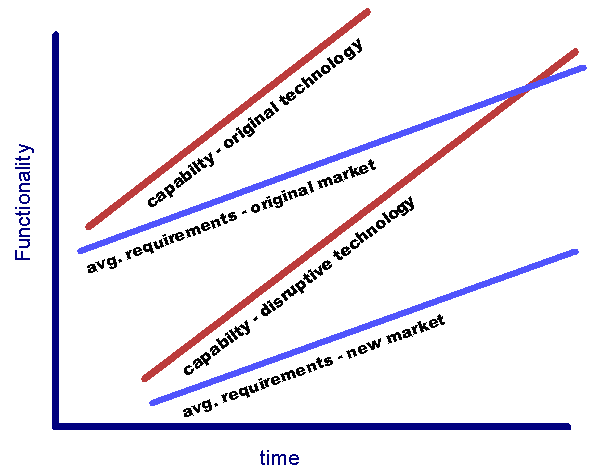
When the capability of the disruptive technology (lower red line) crosses the average market requirements of the original market (upper blue line) all the customers on the upper tier "jump ship" and buy from vendors in the lower market. If the company in the original upper market has other product lines, they may survive, grumbling how you "just can't make money" in the lower tier (this is what SGI says about PCs and Sears says about discount marts); if not, they will probably vanish, like DEC.
You can also find this dynamic discussed by Kevin Kelly in his 1997 essay in Wired, "New Rules for the New Economy" (archived on-line at: www.wired.com/wired/5.09/newrules_pr.html).
It is important that the leadership of SIGGRAPH come to understand these market forces, because they impact our members, our vendors, and our conference. In the case of our annual conference the Web itself makes many of the functions of conferences obsolete, and we need to adapt to this change.
It is also a problem that SIGGRAPH was the "it" conference for a while. It not only stood for 3D graphics and interactive technology, but for technical change in general. But 3D is now getting stale. On the way to the 2003 conference each day I passed a billboard advertising Seaworld's new "Haunted Lighthouse in 4D." I got it: 3D tired, 4D wired. It may be the case that SIGGRAPH will never be the "it" conference again.
The spirit of Christmas Yet To Come took Ebenezer Scrooge to see his own grave. Would the Spirit of SIGGRAPH Yet To Come take us to see the grave of SIGGRAPH, perhaps archived in one last ACM report on the fate of a money-losing SIG that used up all its credit and good will? I suggest that SIGGRAPH could meet a grander fate: destroy it on purpose. Announce in 2005 that 2009 will be the last SIGGRAPH. This will get attention, including media attention. All the old friends of SIGGRAPH will come out of the woodwork, either to try to "save it" or to attend the "wake."
Then, in 2010, replace it with two SIGS: SIG3D and SIGedge. SIG3D should be like SIGGRAPH was around 1983 -- an academic conference on rendering algorithms, exclusive and pricey, with a small exhibition. SIGedge should be like ComiCon meets E3 at Burning Man, family-friendly style. It should be someplace cheaper than a convention center (with its inflated prices for parking, lodging, food and transportation), and be low-enough priced so artists, students, teachers, and just plain folks can get in. Every year there are swarms of people who want to get into SIGGRAPH but can't afford it. We need to target them en masse. Imagine a big VR circus in a mall parking lot that tours the country. If it got big enough it could earn money to support the other more academic SIGs.
I don't know if I have the right answer here for saving SIGGRAPH, but if it stimulates thinking and discussion in the SIGGRAPH community I will have accomplished my goal in writing this article.
-- Alan Scrivener, 24 October 2003.
www.siggraph.org/conferences/cag/finexe.html
(I haven't had a chance to update the graph and table above.)